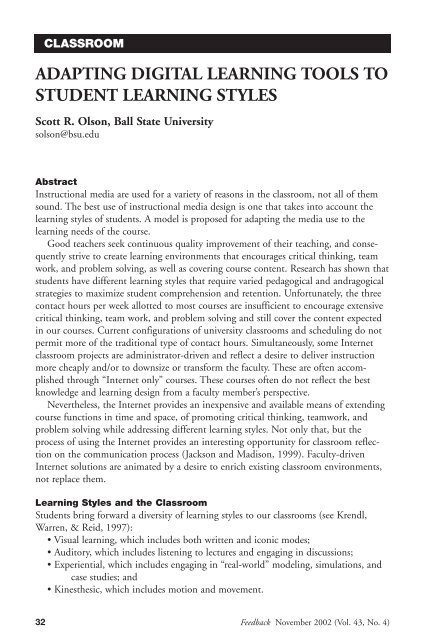CLASSROOMADAPTING DIGITAL LEARNING TOOLS TOSTUDENT LEARNING STYLESScott R. Olson, Ball State Universitysolson@bsu.eduAbstractInstructional media are used for a variety of reasons in the classroom, not all of themsound. The best use of instructional media design is one that takes into account thelearning styles of students. A model is proposed for adapting the media use to thelearning needs of the course.Good teachers seek continuous quality improvement of their teaching, and consequentlystrive to create learning environments that encourages critical thinking, teamwork, and problem solving, as well as covering course content. Research has shown thatstudents have different learning styles that require varied pedagogical and andragogicalstrategies to maximize student comprehension and retention. Unfortunately, the threecontact hours per week allotted to most courses are insufficient to encourage extensivecritical thinking, team work, and problem solving and still cover the content expectedin our courses. Current configurations of university classrooms and scheduling do notpermit more of the traditional type of contact hours. Simultaneously, some Internetclassroom projects are administrator-driven and reflect a desire to deliver instructionmore cheaply and/or to downsize or transform the faculty. These are often accomplishedthrough “Internet only” courses. These courses often do not reflect the bestknowledge and learning design from a faculty member’s perspective.Nevertheless, the Internet provides an inexpensive and available means of extendingcourse functions in time and space, of promoting critical thinking, teamwork, andproblem solving while addressing different learning styles. <strong>No</strong>t only that, but theprocess of using the Internet provides an interesting opportunity for classroom reflectionon the communication process (Jackson and Madison, 1999). Faculty-drivenInternet solutions are animated by a desire to enrich existing classroom environments,not replace them.Learning Styles and the ClassroomStudents bring forward a diversity of learning styles to our classrooms (see Krendl,Warren, & Reid, 1997):• Visual learning, which includes both written and iconic modes;• Auditory, which includes listening to lectures and engaging in discussions;• Experiential, which includes engaging in “real-world” modeling, simulations, andcase studies; and• Kinesthesic, which includes motion and movement.32<strong>Feedback</strong> <strong><strong>No</strong>vember</strong> <strong>2002</strong> (<strong>Vol</strong>. <strong>43</strong>, <strong>No</strong>. 4)
Courses do not always engage all of these styles, not even “live” courses in a traditionalcampus setting. Internet courses, the early versions of which tended to be text-based,are often overwhelmingly visual to the exclusion of the other styles.Intersecting these different learning styles are the types of students a university facultymember is likely to encounter. In a further refinement of Krendl, Warren, and Reid(1997), Gorham (1999) created a taxonomy of four different types of students basedon their preferred method of learning:Type One: Learners who are Concrete, Experiential, Reflective, and ObservationalType Two: Learners who are Abstract, Conceptualizing, Reflective, andObservationalType Three: Learners who are Abstract, Conceptualizing, Active, and ExperimentalType Four: Learners who are Concrete, Experiential, Active, and ExperimentalEach of these types of learners learns best through a different pedagogical orandragogical strategy. Those strategies are detailed in the chart below (see Figure 1).Figure 1. Learning Styles and the Enriched ClassroomLearning Style Teaching Strategy Enrichment StrategyType 1: Concrete, Brainstorming, Teamwork, Online groupsExperiential, Reflective, Faculty empathy Group websitesObservationalThreaded discussionsType 2: Abstract, Structured Exercises Weekly online quizzesConceptualizing, Data collection and Online researchReflective,processingObservationalType 3: Abstract, “Coaching” Email mentoringConceptualizing, Active, Hands-on activities Online cases andExperimentalSimulationsType 4: Concrete, Trial and error Course contentExperiential, Active, Independent self-discovery (lecture notes, readings, etc.)ExperimentalInteractive puzzles andgamesOf course the classroom is more than a mere mode of information delivery, andfaculty members have goals that build on the transmission of course content. Thesegoals include an enriched faculty/student relationship, inculcating leadership, fosteringcreativity, motivating students, and other functions (Strauss and Frost, 1998).The most effective way to create a learning environment that encompasses studentlearning style diversity and the faculty’s outcome goals is to use a variety of teachingBEA—Educating tomorrow’s electronic media professionals 33
- Page 2 and 3: Feedback November 2002 (Vol. 43, No
- Page 4 and 5: CommentSWOT Analysis: Disney Consid
- Page 6 and 7: without adding enough people to do
- Page 8 and 9: his favorite questions for prospect
- Page 10 and 11: The intellectual satisfaction you
- Page 12 and 13: Finding qualitative evidence via te
- Page 14 and 15: 2 Using a two-tailed Pearson Correl
- Page 16 and 17: • We need to expand digital editi
- Page 18 and 19: Two final points: While this paper
- Page 20 and 21: 1. As elsewhere in the profession,
- Page 22 and 23: EvaluationThere will be approximate
- Page 24 and 25: CLASSROOMEMPHASIZING ETHICS: PROMOT
- Page 26 and 27: “Avoiding Plagiarism” ( http://
- Page 28 and 29: CLASSROOMMULTIMEDIA FOR MORTALS: RE
- Page 30 and 31: Video files come in a variety of di
- Page 32 and 33: CURRICULUMDISMANTLING THE SILOS: MO
- Page 34 and 35: the Web on deadline and conceptuali
- Page 38 and 39: strategies. Unfortunately, most tex
- Page 40 and 41: Figure 2. Good Practice and the Enr
- Page 42 and 43: CLASSROOMSTUDENTS TACKLE SUPER BOWL
- Page 44 and 45: Usually, I urge students to use the
- Page 46 and 47: aggression with intelligence, when
- Page 48 and 49: e lost in sole reporting of undiffe
- Page 50 and 51: COMMENT“SCHOOL DAYS, SCHOOL DAYS,
- Page 52 and 53: CLASSROOMSWOT ANALYSIS: DISNEY CONS
- Page 54 and 55: analysis. SWOT is an acronym for St
- Page 56 and 57: Disneyland ResortDisney Vacation Cl
- Page 58 and 59: CURRICULUMDON’T ISOLATE E-BUSINES
- Page 60 and 61: mention implications from legal and
- Page 62 and 63: viable media alternative to televis
- Page 64 and 65: management are needed to deliver th
- Page 66 and 67: Humboldt, Chris (2000). How E-comme
- Page 68 and 69: editing is a place of influence. St
- Page 70 and 71: COMMENTYO, YO, YO! THIS IS THE HIP-
- Page 72 and 73: REVIEWSchroeder, Sheila E. (2002).
- Page 74 and 75: ANNOUNCEMENTS2003-2004 Scholarship
- Page 76 and 77: ANNOUNCEMENTSBroadcast Education As
- Page 78: NEWSJohn Mark DempseyUniversity of
















